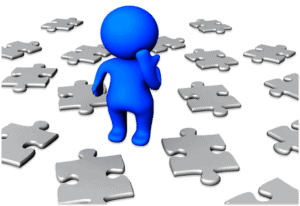Do you or your team have days like this? Days where you remember at the end of the day that you wanted to contact that customer who hasn’t responded to your email proposal. And you also need to call and recover the relationship with another customer after the service delivery team didn’t quite understand what the customer’s arrangements and expectations were, making a tricky situation even worse. All the while you are wondering who is going to send information to all those leads who downloaded the great e-book that just went up on the website, while you are flat out just trying to manage a pipeline that is too big, but not big enough at the same time.
You know you need a Customer Relationship Management system (CRM) to help automate and streamline you and your team’s work, but what is the right CRM? There are so many out there!
One of the questions most frequently asked by business owners and sales leaders in businesses of all sizes is What is the best CRM?.
A better question is “What is the right CRM for my business?” and it is a question that is not easy to answer. I have been selecting and implementing CRM software for businesses for my whole career, and it took me ages to select the CRM that is right for me. It can be hard and confusing.
The first step to selecting the right CRM is to understand what you need the CRM to do, which can be easier said than done. If you don’t have experience with CRM, how are you supposed to know what your requirements for one are? Where do you even start?
The good news is that there is a simple process that not only helps you clarify your requirements but then walks you through how to convert that into the selection and implementation of a CRM. Let me walk you through that process now.
 Step 1: Understanding what you might need to the CRM to do
Step 1: Understanding what you might need to the CRM to do![]()
I just said this was hard, didn’t I? But it is not as hard as it seems. Don’t start with the system you are buying, start with your customers.
Who are they? Are they individual buyers buying a low price consumer product? Or are they small business owners? Or are they large organisations where you are talking to many different people over a long period of time to win the business?
Now, think about the interactions with your customers. Note down the important interactions, and how might you do them better.
For example, is it crucial to have a great way to manage online interactions, particularly emails, and how they are converting to website visits and sales? Or is it the combination of meetings, phone calls and other personal interactions with your team that lead your customers through their buying journey?
Is it most important that you manage service delivery? Or is it helping everyone in your team to consistently and effectively handle customer service questions, requests, and problems? Or are there some very special interactions that help you provide your unique services?
Step 2: Understand (and quantify!) the benefits CRM will give you, and how that will cover the cost
The benefits
- What sort of things could better interactions with your customers give you?
- Will following up leads with automated email marketing systems convert more of your leads to customers, giving you more revenue?
- What would a 1% improvement in your conversion rate give you?
- Would you keep more of your existing customers if you could provide more consistent customer service?
- Or do you have processes in your business that are taking much longer than they should be that you could automate, allowing you to divert your team to higher value activities or hold off hiring new staff?
Being clear on what value you expect, with an estimated dollar amount, will help you make good decisions in selecting and implementing a CRM, especially if you link this value back to the customer activities that you listed in step one.
The benefits will need to more than cover the cost of buying, implementing and running your new CRM. The revenue or savings you expect is only one side.
The costs
There are important factors inside your business that will impact the cost of buying, setting up and running your CRM.
- Do you have a lot of technical expertise in your business, with free time to spend on this project? Or will you need to bring people in, with new skills or just more time?
- Does your whole team need new skills to set up or use the system?
- Do you already have systems in place that will need to be linked (either manually or automatically) to your new CRM? Those links can be costly to put in place unless they work “out of the box” with the CRM you buy.
- It can also be expensive if there is a lot of existing customer data that you need in the CRM. How much customer history will you need?
Step 3: Select the product(s) that best fits
 Now you know a lot about what you need your CRM to do, it is much easier to select the right product.
Now you know a lot about what you need your CRM to do, it is much easier to select the right product.
Is your main thing emails and online communication? If so, focus your search on tools with email marketing capabilities.
If you sell complex products to cross-functional B2B buying teams, then sales and pipeline management will be crucial, perhaps indicating you need a tool with very strong sales process support.
You might not get to a final answer here, but it should get you a shortlist. Remember to give priority to the capabilities that drive the highest benefit.
Some of the most CRM functions you might look for are:
- Core relationship management
Keeping track of your customer records, the people and organisations you deal with, and the interactions you have with them. You might need something specific like a customer meeting booking tool, or just want to keep general records. - Marketing automation
Everything from bulk email sends to having sophisticated links with your website and automated multi-step, multi-channel marketing campaigns. - Sales pipeline management
Identifying sales opportunities in your customers, and tracking them. - Sales territory management
Used when multiple salespeople need to be assigned responsibilities within the CRM. - Service management
Managing customer questions and requests for service, again this can be quite basic or very sophisticated, with links to phone systems, website, and online forms. - Field service
When you have service people visiting customers, this can include everything from service bookings to route plans. - Project delivery
To keep track of the complex delivery of your product to the customer, for some people this includes complex billing needs too. - Dashboards and reporting
If you have a large team and many customers, it might be important that your CRM can provide a great management view for you to look into team activities and customer outcomes.
It can be as easy as googling some of these terms, or specific needs you have – like a link to your accounting system – and drilling down from there. Alternatively, you might write down your list of essential functions and ticking off the products that seem to meet those needs, then downloading trial versions. Or you might go through a more formal procurement process if you are spending lots of money.
Step 4: Plan your purchase and implementation
Once you have a list of products you might want to use, the final step is to plan the implementation, and compare your shortlist based on a full set of costs:
- What are the license/subscription costs?
Perhaps map it over 3-5 years to get a full picture - Will you need help to set up your CRM?
And if so, is there a selection of good partners available to help? How much would they be charging you? And is that a one-off cost, or an ongoing one? - Will you be able to use your new CRM exactly as it comes?
Or will you need to spend a lot of time tailoring it to your business? - Will you need to spend a lot of time learning about all the features and capabilities of your new CRM?
Who will train your team in the new tool – is that something you can do yourself, or will you get one team member to train others, or get someone from outside to do all the training for you? - Do you need links to other systems you use?
Do they come “out of the box” with the CRM in a way that works for you? Or will you need someone to build an automated link or have someone copying data manually? Similarly, what about bringing in your existing customer information? - One last check:
Can you get your information out again if decide to stop using this CRM? Make sure you own your data and can get it out if necessary. You might also want to check how long you might be locked into this purchase.
Once you have weighed up the full costs you can make sure the benefits will cover the ongoing costs of access for your team and pay back some of the setup costs too as you start to use it.
Are you ready to get started?
These are the steps that you need to follow whether you are looking at a small CRM purchase or a large one! Even with a lot of knowledge and experience, this can be time-consuming but with the steps above you will make a good decision.
Do you need some help with this process? Contact frieda@salespod.com.au for information on how SalesPOD can help you navigate this process.
